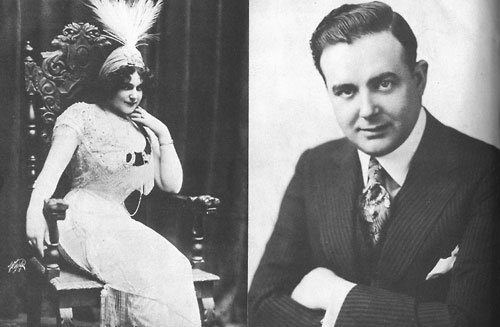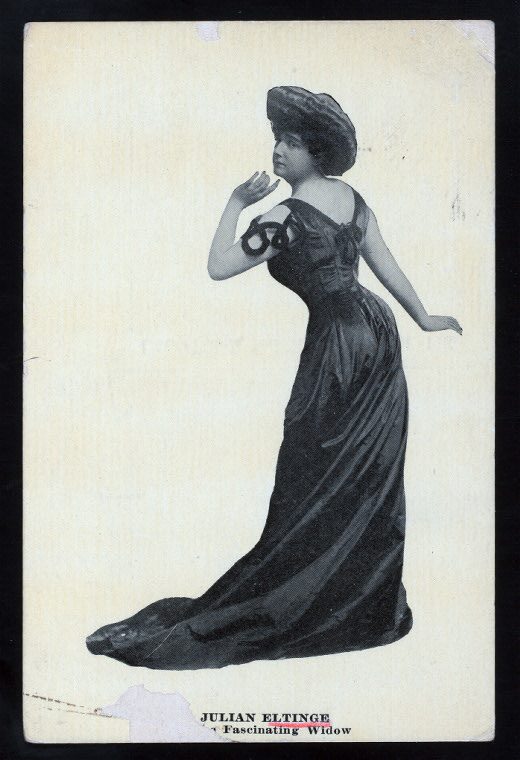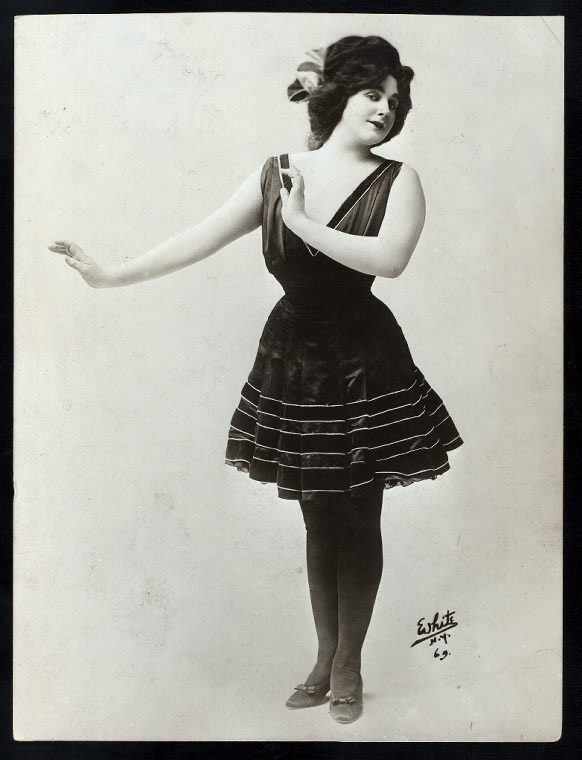Drag is having its moment. The great success of Ru Paul’s Drag Race, as well as re-evaluations of the skill of drag performers such as Divine, shows that the artform is being taken more seriously than ever before. It provides a strange parallel to one hundred years ago. While attitudes to gender and sexuality were undoubtedly more conservative in the 1920s, drag nonetheless proved that it could be commercially successful and artistically magical. All embodied in its forgotten star, Julian Eltinge.
Eltinge’s story is indicative of the strange role occupied by drag at the turn of the 20th century. Female impersonation—the transformation of men into realistic and artistic representations of women—was a common theatrical trope, but is distinct from “dragging up” in the vaudevillian style. Eltinge was popular enough to have a theatre named after him, but by the 1930s his career had entirely collapsed due to a fervour of anti cross-dressing homophobia. However, Eltinge’s drag points the way forward for its modern incarnation; the complete transformation into a female identifying-character, the delicate balancing of the on and off-stage persona, and the deep-rooted sense of theatricality. Although his death at 59 has left him largely confined to the footnotes of queer history, his bravery and style should be celebrated.
Eltinge was born in Newtonville, Massachusetts on 14 May 1881, as William Julian Dalton. His first taste of the limelight came at the age of ten, in the Boston Cadets Review, and in performances in his teens at bars and saloons. Reportedly, when his father discovered his son’s predilection for female clothing, he took him home and beat him. His first major success came in February 1900, in a production of Malady and the Musketeer at Boston’s Tremont Theatre, after which he changed his name to Eltinge after a childhood friend. Many reviewers were enamoured with his skill from the off. One Boston Globe review called him “the bright particular star of the show… a triumph of the art of imitation.” From the beginning, Eltinge loved to play with the blurred lines between male and female, and their capacity for transformation.
By 1904, Eltinge had been scouted by producer E.E. Rice, who brought him to New York to play in the vaudeville show Mr. Wix of Wickham. Based on the British play Charley’s Aunt, the show allowed Eltinge to play many cross-dressing roles, such as as a Spanish dancer or blushing bride, demonstrating his incredible transformative abilities. Other productions were toured across Europe and the United States, culminating in a command performance before King Edward VII in 1906. From 1910, he starred in a series of successful musical comedies on Broadway, such as The Fascinating Widow and The Crinoline Girl. Although these were unpopular in New York (Widow closed after only 65 performances), Eltinge took them on the road and delighted audiences for several years after.
Many of these shows had the comedic motif of Eltinge’s character being forced to dress as a woman in order to pull off a prank or reverse a mistake, in the Shakespeareian tradition, and therefore making a virtue of the taboo of crossdressing. In this way, Eltinge’s persona allowed his masculinity to remain intact, while constructing incredibly convincing performances as a woman. In 1912 he was publicly lauded in New York when The Eltinge Theatre was dedicated to him on 42nd Street. This was followed by a brief but successful film career. In 1917, he appeared in his first feature, The Countess Charming, which led to other productions including The Isle of Love with Rudolph Valentino.
By the time he arrived in Hollywood, Eltinge was one of the most well-paid actors in America. This was likely due in part to the care Eltinge took, both in the creation of his feminine persona and the distance he sought to keep this from his public image. He became so known for his elegant costumes and makeup that he launched his own facial creams and wrote in a magazine with beauty tips for women, and often took up to two hours with his costumer, Shima, to prepare for a performance. In a 1913 article for The Theatre Magazine, Eltinge wrote “the hands are of greatest importance in my impersonation, for they must be made to look quite feminine… the size of the hands can apparently be decreased by the way in which they are held… the first rule is never to allow the breadth across the back of the hands to be seen so that the narrowest portion, for instance, the thumb and forefinger or the little finger, will show.” Such was the skill and dedication he possessed that in some ways it is little wonder his services were in such high demand.
So too was this delicacy an attempt to redeem drag from its slightly seedy image as the preserve of dive bars. He refused to caricature women in the vaudeville tradition of Dan Leno, focusing instead on the seamless transformation and the rejection, rather than comedic possession, of his masculinity. This gave him many female fans, whilst also apparently making heterosexual audience members uneasy. As the comedian W.C. Fields noted, “women went into ecstasy about him. Men went into the smoking room.” Eltinge rejected comedic sexuality in favour of the importance of illusion and style.
But at the same time Eltinge made concerted efforts to appear overtly masculine to the public eye. Although no lovers of any gender have ever been recorded, the critical perception is that Eltinge was gay, at a time when the hyper-masculine society rejected both drag and homosexuality in general and barely accepted them within theatre. Eltinge was apparently rejected by the sophisticated New York clientele, and in particular by heterosexual male audiences. As a result, Eltinge went the extra mile to appear as a typical all-American man offstage. He engaged in frequent fistfights, cigar smoking, and extended “romances’’ with women, all captured in staged publicity photos. Multiple reports claim that Eltinge befriended columnists in the cities he visited to ensure that his masculine activities would be well-covered in the papers. His Japanese dresser, Shima, became a kind of prop, his presence meant to demonstrate how Eltinge did not enjoy his drag, rather treating it as a steady gig that entertains the paying public. Eltinge went to extreme lengths in creating both hypermasculine and ultrafeminine personas, highlighting the social tensions of cross-dressing in this period, as well as demonstrating the performative nature of gender more generally.
By the 1930s, however, Eltinge’s style of drag had become unpopular, and not only within the mainstream. New York’s queer scene, too, had moved beyond Eltinge’s straightlaced style, favouring instead the outrageous performances of Francis Renault and Bert Savoy. Throughout the early 1900s in the USA, there was a more relaxed attitude towards homosexuality, overwhelmingly due to ignorance and lack of awareness as opposed to conscious acceptance. By the latter half of the 1920s however, a more actively conservative mood had taken hold, as seen in the case of William Haines, whose career imploded due to his refusal to deny his sexuality. This contrasts starkly to the openness of artists such as Mae West earlier in the decade. Crackdowns on cross-dressing in public, clamping down on perceived homosexual activity, heavily impacted Eltinge’s act. In some cases he had to perform standing next to the costumes he once wore on stage. This was not helped by the fact that Eltinge, sans femininity, was apparently not quite as good an actor, his talent seemingly contained within the illusion. His image was tarnished further by the bad press resulting from his liquor smuggling trial in 1923, at the height of the Prohibition era. Dwindling opportunities culminated in Eltinge’s early death in 1941, ten days after his final performance at Billy Rose’s Diamond Horseshoe nightclub.
Julian Eltinge embodies what makes drag an artform; the impeccable transformation, the sense of liberation, the blending of the male and female. But he also represents the ambiguous attitudes towards gender and sexuality in the early 20th century, a time when a cross-dressing performer could find great success – as long as it was firmly within the conventional boundaries of sexuality. Eltinge shows that the detail, theatricality and illusion associated with drag today have always existed in cross-dressing, and reminds us of the prejudices faced by these artists within wider society. He deserves to be remembered as a trailblazer, and most importantly, an artist.
Words by Issy Flower
This article was published as part of The Indiependent‘s May 2021 magazine edition.
Support The Indiependent
We’re trying to raise £200 a month to help cover our operational costs. This includes our ‘Writer of the Month’ awards, where we recognise the amazing work produced by our contributor team. If you’ve enjoyed reading our site, we’d really appreciate it if you could donate to The Indiependent. Whether you can give £1 or £10, you’d be making a huge difference to our small team.


